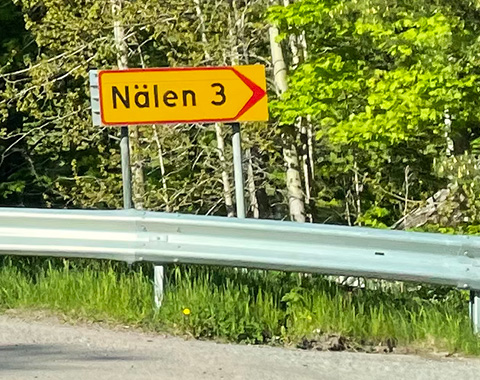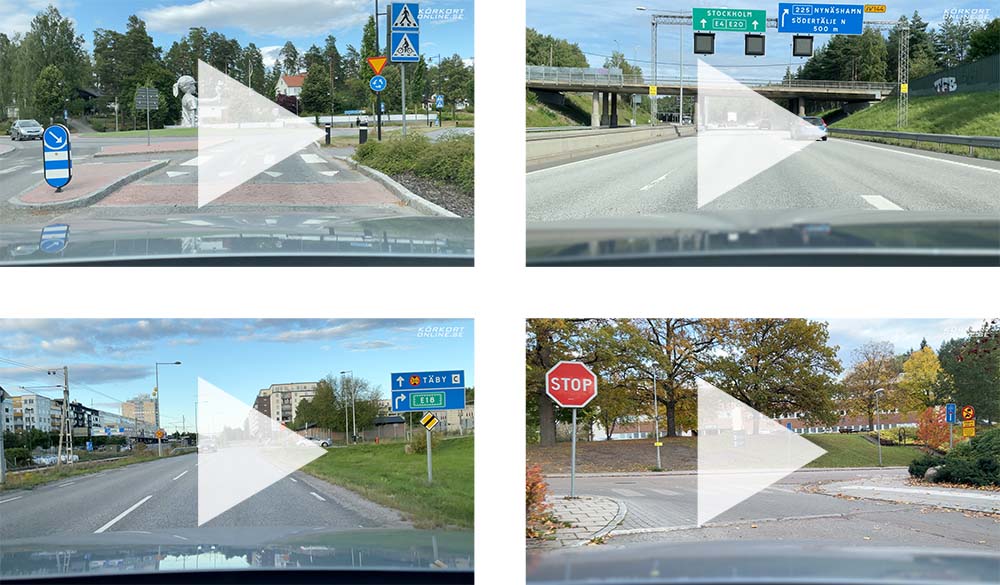Driving on a country road
On country roads, the speed limit is higher than in built-up areas. For this reason, it is important to have good safety margins and to pay attention to what is going on further down the road.
Turning on a country road
Right turns
Indicate in good time and slow down gradually. If visibility is good, you may drive on the hard shoulder just before the turn, as this makes it easier for the vehicles behind you to pass.
You want to turn right. The visibility is good and the hard shoulder is wide. You can use the hard shoulder to make it easier for vehicles behind you to pass.
Left turns
Turning left on a country road is the most dangerous type of turn you can make. The reason for this is that you are driving at high speeds. A rear-end collision can be very serious.
How to make a left turn, and possible ways to reduce the risks:
- Check the traffic flow
In rush hour traffic, it can be difficult to find a gap to use for your turn. In that case, it is safer not to make the turn, but instead drive straight ahead, turn at a suitable location, and then come back and make a right turn. If there is less traffic, continue to the next step. - Indicating and positioning
Indicate in good time, and position your car as close to the centre line as possible. This makes it easier for other traffic users to see that you are turning. If you position your car in the middle of the lane, it is possible that the cars behind you will not notice you slowing down, which can result in a rear-end collision, or a side collision if the car behind you starts overtaking at the same time as you make the turn. - Avoid stopping
Adapt your deceleration before the turn so that you do not have to stop and wait for the oncoming lane to be free of traffic. If you have to stop, be sure to not turn the wheels to the left, as a collision from the rear would push your car forwards into the lane of oncoming traffic. - Focus on making the turn
Once you are ready to turn, it is important to focus on the distance to the oncoming traffic. Also remember to put the car in the right gear and accelerate fairly quickly until you are safely on the new road. Stalling in the middle of the oncoming lane is dangerous.
In order to reduce the number of left turns, the road is sometimes redesigned as a jughandle turn (sometimes known as a Spanish turn). This means that you turn off onto a small exit road on the right, and then cross the road.

Direction sign when junction turn is prohibited (“jughandle turn”)
You want to turn left. Being hit from behind is a real danger here, as you will be forced to stop and wait for oncoming traffic to pass.
This is a jughandle turn. You want to turn left, but if you turn at B you may be forced to stop and wait for oncoming traffic to pass. Instead, you must turn at A and cross the road, thereby avoiding the risk of a rear-end collision.
Maintain the appropriate distance

The distance is insufficient. Note the verge posts.
It is very common to see drivers not maintaining a sufficient distance on country roads. There are a few rules of thumb below that you can use to ensure you are keeping an appropriate distance.
- The three-second rule
Start counting when the car in front of you is at a fixed point (such as a road sign) and stop counting when you reach that point yourself. If it took less than 3 seconds, the distance between you is too short. - Verge posts
The distance between two white verge posts is 50 metres. A good distance to maintain from the car in front of you on a country road is 100 metres, which corresponds to the distance between 3 verge posts. - Km/h to metres
Change your speed in km/h to metres to give the distance that is appropriate to maintain from the car in front – e.g. a distance of 90 metres when travelling at 90 km/h.
If the car behind you is too close
Cars that drive too close to you are both annoying and dangerous. You can reduce the risks by maintaining a large distance from the car in front of you, which means that you would not have to brake as hard if the car in front of you were to slow down. This reduces the risk of you being hit from the rear.
Another option is to pull over into an appropriate lay-by or parking space, and allow the stressed driver behind you to pass.
Meeting oncoming traffic on a narrow road
- The basic rule is that you should keep to the right in order to have as great a safety margin as possible.
- The first car to arrive at the passing place shall stop, irrespective of which side the passing place is on.
- If there is an obstacle on the road, the car whose side the obstacle is on shall stop and allow oncoming traffic to pass.
Roadworks
- Drive slowly. The road workers must do their jobs while also keeping an eye on traffic.
- Temporary orange road signs and yellow road markings take priority over the regular signs.

You are approaching an area with roadworks. Maintain a low speed and be particularly attentive. The marking for obstacle on the side is placed so that the yellow panels lean downwards on the side where traffic must travel.
Horses
Horses in traffic require special consideration:
- Lower your speed.
- Ensure you leave more space to the side of the car than normal.
- Do not sound your horn or dazzle with your headlights.
- Accelerate calmly (the sound of the engine may frighten the horse).
Also remember that riders may often be young, with little experience of traffic. It is very helpful to make eye contact with the rider.

Sign indicating a private road.
Private roads
If you encounter a sign indicating a private road, you should be prepared for the following:
- Poor road standard.
- Lack of road signs.
- Narrow roads with sharp turns.
Think also about your speed. Just because the speed limit is often 70 km/h, it is not always appropriate to drive at 70 km/h. If you were to crash on a bend on a narrow road with obscured visibility, this could be classed as reckless driving if you were driving at 70 km/h.
Clarification on private roads
Does the priority-to-the-right rule apply at junctions between a private road and a regular public road?
– Yes. There are no special rules for giving way at junctions between a private and a public road. If there are no road signs denoting priority road/obligation to give way, it is the priority-to-the-right rule that applies, as long as the private road is not classed as an exit. Read more about the exit rule in the section on Priority rules.
Road numbers
| Regular road number | Dashed border |
 You are on road 58. |
 The road you are on is leading to road 58 further ahead. |
If you drive straight ahead at the roundabout, you will immediately join road 53. If you turn left, you will join a road that leads to E20 and road 56.
Verge posts
On country roads, there are often verge posts with reflectors that help you see how the road continues further ahead.
On the left side of the road, the reflectors are round to warn of oncoming traffic. On the right side of the road, the reflectors are rectangular.
On motorways, the reflectors are rectangular on both sides, as there is no oncoming traffic.
The reflectors are white if the road continues without interruption. At junctions, bus stops and parking spaces, the reflectors are yellow.
The distance between verge posts is normally 50 metres (100 metres on motorways, 25 metres in bends).
| Left | Right |
 |
 |
The verge post on the right has a yellow reflector to mark the junction.




